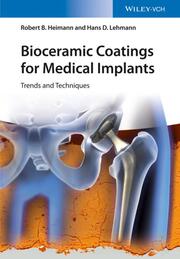Detailansicht
Bioceramic Coatings for Medical Implants
Trends and Techniques
ISBN/EAN: 9783527337439
Umbreit-Nr.: 7414395
Sprache:
Englisch
Umfang: XXII, 496 S., 150 s/w Illustr., 20 farbige Illustr
Format in cm:
Einband:
gebundenes Buch
Erschienen am 08.04.2015
Auflage: 1/2015
€ 179,00
(inklusive MwSt.)
Nachfragen
- Zusatztext
- Reflecting the progress in recent years, this book provides in-depth information on the preparation, chemistry, and engineering of bioceramic coatings for medical implants. It is authored by two renowned experts with over 30 years of experience in industry and academia, who know the potentials and pitfalls of the techniques concerned. Following an introduction to the principles of biocompatibility, they present the structures and properties of various bioceramics from alumina to zirconia to calcium phosphates. The main part of the work focuses on coating technologies, such as biomimetic deposition, sol-gel deposition, magnetron sputtering, and thermal spraying. Then follows a discussion of the major interactions of bioceramics with bone and connective tissue cells, complemented by an overview of the in-vitro testing methods of the biomineralization properties of bioceramics. The text is rounded off by chapters on the functionalization of bioceramic coatings and a look at future trends. As a result, the authors bring together all aspects of the latest techniques for designing, depositing, testing, and implementing improved and novel bioceramic coating compositions, providing a full yet concise overview for beginners and professionals.
- Kurztext
- InhaltsangabePREFACE BIOMATERIALS - A HISTORICAL PERSPECTIVE THE NATURE OF BIOCERAMIC MATERIALS SCOPE AND SOCIOECONOMIC ASPECTS OF BIOCERAMICS Europe USA and Canada Asia PRINCIPLES OF BIOCOMPATIBILITY Bioinert Ceramics Biotolerant Ceramics Bioactive Ceramics Osseoconduction vs. Osseoinduction HIERARCHICAL STRUCTURE OF BONE TISSUE FUNDAMENTALS OF INTERACTION OF BIOCERAMICS AND LIVING MATTER Tissue Level Cellular Level STRUCTURE AND PROPERTIES OF SELECTED BIOCERAMICS Bioinert Ceramics: Alumina, Zirconia, Titania, and Others Bio(osseo)conductive Ceramics: Bioglasses, Hydroxyapatite, Tricalcium Phosphates, Tetracalcium Phosphate, Transition-Metal Substituted Calcium Orthophosphates, Resorbable Calcium Phosphates, Composite Materials, and Others TECHNOLOGY OF COATING DEPOSITION Biomimetic Route SolGel Deposition Dip Coating Electrochemical Deposition Electrophoretic Deposition Chemical Vapor Deposition (CVD) Ion Implantation Magnetron Sputtering Plasma Electrolytic Oxidation (PEO) MicroArc Oxidation (MAO) Laser Cladding Thermal Spraying (APS, HVOF, PLD, etc.) Suspension Plasma Spraying (SPS) Cold Gas Dynamic Spraying (CGDS) Others STRUCUTRE, PROPERTIES, AND BIOLOGICAL FUNCTION OF BIOCERAMIC COATINGS In Vitro Behavior In Vivo Behavior IN VITRO TESTING BIOMINERALIZATION PROPERTIES OF BIOCERAMIC COATINGS Composition of Solutions Mimicking Human ECF (Extracellular Fluid) Biomineralization by Immersion in ECF-Simulating Solutions Cell Proliferation, Spreading, Vitality and Differentiation Studies ISO10993 Standard Testing Alkaline Phosphatase (ALP) Assay Using ELISA Osteocalcin Secretion Osteopontin and Osteonectin Assays Others CHEMICAL AND BIOLOGICAL FUNCTIONALIZATION OF BIOCERAMIC COATINGS FUTURE DEVELOPMENT AND OUTLOOK
- Autorenportrait
- Robert B. Heimann is Professor (em.) of Applied Mineralogy and Materials Science, formerly at Technische Universität Bergakademie Freiberg, Germany. He received his scientific degrees from Freie Universität (FU) Berlin, Germany, and served as a research fellow at FU Berlin and the Karlsruhe Institute of Technology. In 1979, he moved to Canada and worked as a research associate at the McMaster University, was visiting professor at the University of Toronto, and held various positions as senior researcher and manager in industry and government institutions. In 1993, he became Full Professor in Freiberg. Until his retirement in 2004, Professor Heimann has authored over 280 scientific publications including several books, was board member and chair of several scientific committees, and vice president and then president of the International Council for Applied Mineralogy (ICAM). In 2001, he was honored with the Georg-Agricola-Medal of the German Mineralogical Society (DMG). Hans D. Lehmann is an organic chemist with an extensive working experience in polymer chemistry and polymer processing technology. He received his Diploma in chemistry from the Martin Luther University Halle-Wittenberg, Germany, in 1962. He worked as a polymer chemist and team leader in production-related research at the chemical company VEB BUNA (now Dow Chemical and Styron Deutschland, respectively). He specialized in the development of polymerization catalysts, modeling of monomer and polymer syntheses as well as their processing technologies and analytics. Moreover, until Germany?s reunification Hans Dieter Lehmann was responsible for the coordination between academia, industry and government. Since 1994 he worked as a consultant for patent law and process concepts, and co-authored several patents related to structural and functional surface coatings
